Photographs by Lalla Essaydi: L’Écriture Féminine / Le Corps Féminin
Elements of tradition and femininity grace Lalla Essaydi’s photographs. These images, while elegant and ethereal, are also brutally honest in their revelation of the artist’s personal history, intimate self, and cultural mores. This exhibition features selections from the artist’s best known work—the photographic series Converging Territories and Les Femmes du Maroc—which have won her international acclaim.
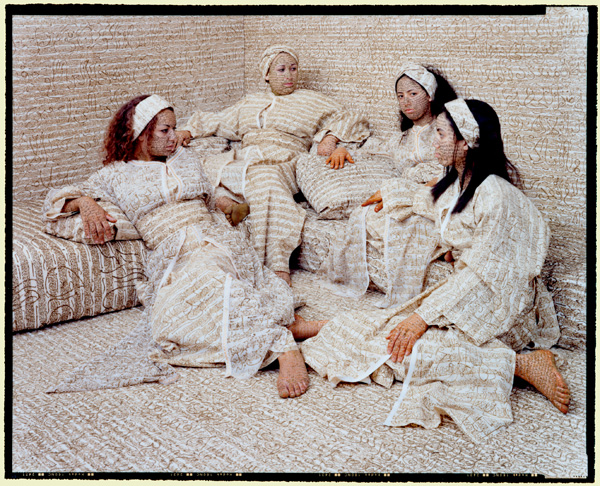 |
| Lalla Essaydi Les Femmes du Maroc, 2006 Chromogenic print on aluminum, 33½ x 40 inches Courtesy of the artist and Edwynn Houk Gallery, New York |
In both series, flowing cloth—pure in its unbleached, natural hue—covers women and scenes that are carefully staged by the artist. In deceptively simple settings, the only visible surfaces are cloth and skin. Essaydi ornately inscribes both with henna, a natural dye associated with women’s adornment throughout the Islamic world.
 |
| Lalla Essaydi Converging Territories #21), 2004 Chromogenic print on aluminum, 40-3/4 x 33-1/4 inches Courtesy of the artist and Edwynn Houk Gallery, New York |
Widely identified with special occasions, the powdered henna, mixed into a paste and applied to the skin, effloresces and wears away. Although henna’s substantive form is ephemeral, its traces remain on the skin for several weeks and record its fleeting presence. In Essaydi’s photographs, delicate webs of henna and its residual designs stream across the picture plane, only intermittently interrupted by a form—a face, a hand, a foot, a flower—that at times also bears its deep red–brown mark. In this context, henna evokes a sense of memory, the reliving of a personal and collective past.
But the delicate patterning is not purely aesthetic, nor are these women merely silent beauties to behold. The design is narrative text, written in Arabic and excerpted from Essaydi’s personal journal in which she considers and reconsiders her experience as a woman, Muslim, Arab, and African. Although she remains behind the camera, these photographs constitute an intimate portrait of the artist.
While the photographs provide a space for Essaydi to voice her own reflections, they are not uniquely personal; they also represent a narrative shared by women with similar understandings of Islamic heritage, cultural mobility, and gender identity. Indeed, Essaydi considers this work a collaborative endeavor undertaken with the Moroccan women who pose for her photographs. The images are captured after hours of preparation. As the models and backdrops are painted with henna, the artist and her collaborators engage in a lively exchange, recounting memories and experiences of being women of Moroccan heritage. The images, then, depict women in repose, caught in moments of quietude, rather than immutably silenced. Essaydi’s photographs reverberate with their conversations, past and present.
The serenity and elegance of these photographs belie their subversive nature. Essaydi transgresses gender stereotypes by using calligraphy, a sacred Islamic art form traditionally reserved for men. Even more, she expresses herself through calligraphic script, rather than writing in the service and spirit of the Qur’an, the Muslim holy book, as convention dictates. Subjecting text and content to her will, the artist employs writing as a delicate act of defiance against a culture in which women have been relegated to the private sphere.
Essaydi’s photographic work challenges conventions of space in multiple ways. This is clearly the case with respect to Islamic cultures in which religion has historically dictated spatial boundaries for men and women. The presence of men defines public venues, streets, and meeting places, while women have customarily been confined to private spaces, though this is increasingly contested by women throughout the Muslim world. The artist also challenges the expectations of viewers, who rely on the clear juxtaposition of positive and negative space and on depth of field as primary points of orientation. This is seldom possible in Essaydi’s photographs in which spatial relationships are obscured by script. Instead, the writing serves as the defining element of the composition, constituting the foreground, background, and subject. The artist removes all allusions to clearly recognizable architectural elements, and substitutes her signature use of henna–inscribed cloth. What remains is, quite simply, space. In Essaydi’s work, it is rarely defined except by the presence of the women who inhabit it. She lures viewers in and, once they are engaged, compels them to make sense of the scene.
The ambiguous space of the photographs resonates with Essaydi’s personal experience and, perhaps, her frame of mind. Relocating multiple times during her lifetime has required multiple reinventions of self, particularly when cultures are crossed, children are raised, and time has passed. The space the artist occupies, then, is ill defined, located between cultures, traditions, and histories. These works, abstracted from a definitive place, conjure the distance between the artist and her homeland.
In Morocco, women have traditionally been expected to remain indoors at most times, and those who transgressed rules of gender conduct have sometimes been subjected to more extreme confinement, a practice only recently abandoned. For the Converging Territories series, the artist revisited a large, unoccupied, family–owned house in Morocco where women who defied traditional gender roles were secluded from others.
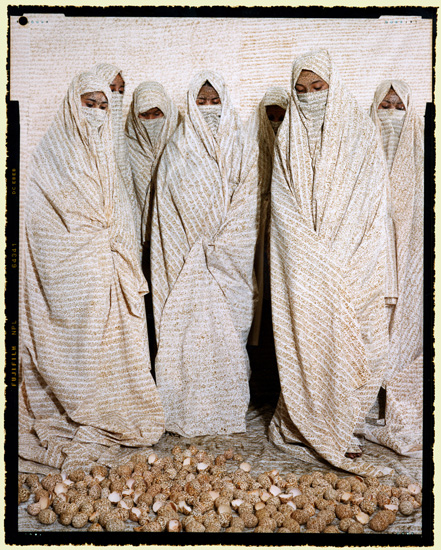 |
| Lalla Essaydi Converging Territories #28, 2004 Chromogenic print on aluminum, 40-1/4 x 32-5/8 inches Courtesy of the artist and Edwynn Houk Gallery, New York |
Returning to her home country and childhood, Essaydi photographed Moroccan women and girls in this family house. In the act of taking it over, she literally redressed it through careful staging. She reversed the connotation of these spaces, transforming them into a place where women are seen, not hidden. Especially when Essaydi’s work is understood as a collaboration between the artist and her models, this site becomes a place of intimate dialogue and expression, where voices are unleashed rather than muted.
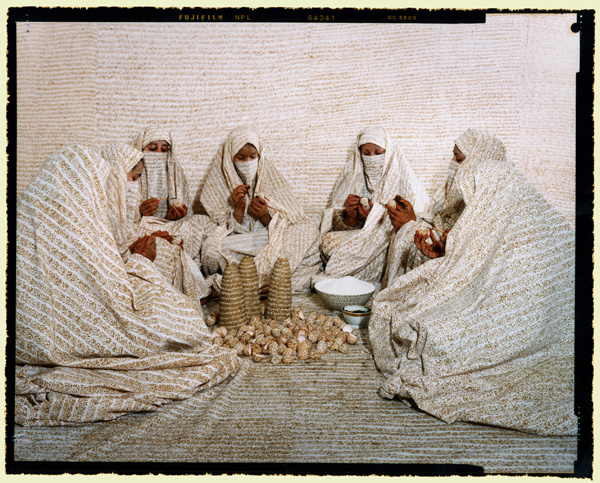 |
| Lalla Essaydi Converging Territories #32, 2004 Chromogenic print on aluminum, 48 x 58-1/8 inches Courtesy of the artist and Edwynn Houk Gallery, New York |
Essaydi’s distinctive artistic process is indebted to Moroccan wedding customs, which include adorning women’s bodies during the Night of the Henna, an elaborate celebration that is a prelude to the wedding itself. On the eve of her marriage, the bride and her female friends and family members come together to apply henna to her hands and feet in intricate designs. In the Apparel still–lifephotographs of the Converging Territories series, instead of ornamenting women’s bodies and skin, Essaydi writes upon objects that are customary wedding gifts, such as flowers, eggs, and sugar. In the context of Essaydi’s larger body of work, in which women’s bodies are so inscribed, the gifts associated with the bride invoke her presence.
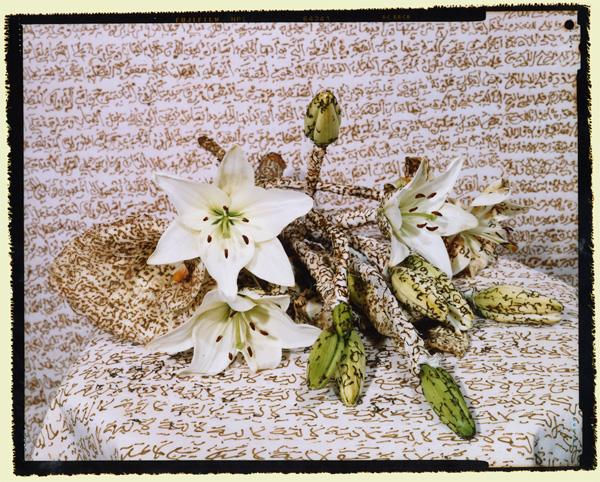 |
| Lalla Essaydi Apparel #6 (flowers), 2003 Chromogenic print on aluminum, 33½ x 40½ inches Courtesy of the artist and Edwynn Houk Gallery, New York |
In Les Femmes du Maroc, Essaydi once again stages Moroccan women in enigmatic spaces awash with text. Rather than taking a site from her past as a point of departure, in this more recent series she engages the imaginary spaces of specific nineteenth–century Orientalist paintings in which European artists rendered their romanticized impressions of the Islamic world. The name Essaydi has given the series, Les Femmes du Maroc, is itself a play on the title Les Femmes d’Algiers (1834), a well–known painting by the French Romantic artist Eugène Delacroix.
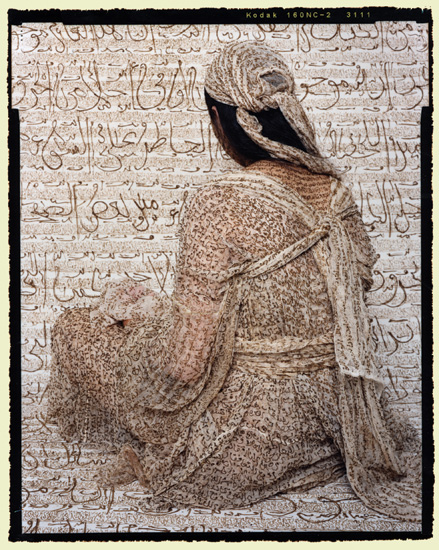 |
| Lalla Essaydi Les Femmes du Maroc: Harem Woman #1, 2008 Chromogenic print on aluminum, 40 x 30 inches Courtesy of the artist and Edwynn Houk Gallery, New York |
Essaydi recasts each painting, stripping it of nearly all decoration and affectation. She removes the opulent color, the elaborate décor, and the male figures that occupy European Orientalist paintings so that, in her own work, women and their gestures become the sole focal point. Rather than simply replicating the centuries–old Western tradition of exoticizing the Eastern “other” and the female body, the artist inserts her own narrative—literally and figuratively—into the images, thereby inviting viewers to reconsider mythologies of an imaginary notion of the Orient. More than simply cultural critique—whether of Arabic, Islamic, or Euro–American narratives—Essaydi subverts the terms of those cultures by appropriating their visual vocabularies.
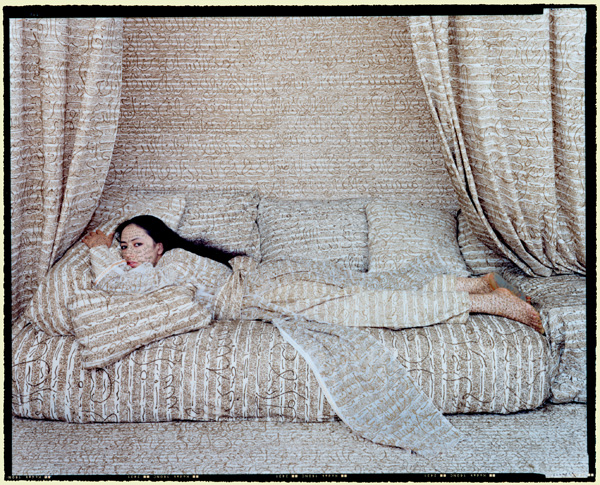 |
| Lalla Essaydi Les Femmes du Maroc 35, 2006 Chromogenic print on aluminum, 34 x 40 inches Courtesy of the artist and Edwynn Houk Gallery, New York |
In one of her signature images from the series, Essaydi reinterprets La Grande Odalisque (1814) by Jean–Auguste–Dominique Ingres; her rendition now resides in the collection of the Musée du Louvre in Paris along with the original painting. By appropriating this imagery, Essaydi directly confronts the manner in which Orientalist paintings have fostered monolithic stereotypes of the Islamic world as exotic, sublime, sensual, and remote. Established during the nineteenth century, these deeply entrenched misconceptions persist and remain highly charged in the twenty–first century.
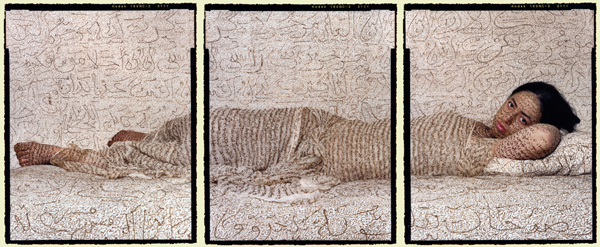 |
| Lalla Essaydi Les Femmes du Maroc 35, 2006 Chromogenic print on aluminum, 34 x 40 inches Courtesy of the artist and Edwynn Houk Gallery, New York |
Together, the works in this exhibition demonstrate the artist’s critical exploration of themes addressing women, space, and memory. While deeply engaged with varied histories, Essaydi’s work is indelibly linked to her own experience and bears witness to her ongoing interrogation of conventional distinctions—women and men, public and private, past and present, self and other, memory and imagination—that beg to be reexamined and reformed. ![]()